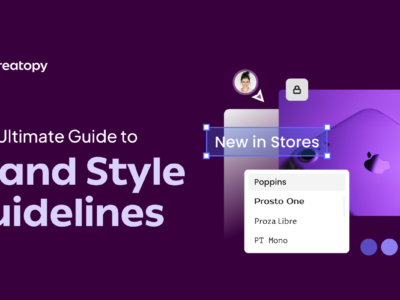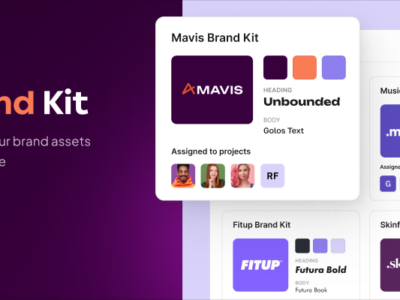Having a clear brand identity is essential to building a strong relationship with your audience and ensuring consistency across all your touchpoints. Without strong brand consistency and a clear brand identity, all the work you put into developing your brand will be lost in translation.
This article will explore the importance of brand identity, how to build a strong brand, and how to ensure consistency across platforms and touchpoints.
Whether you’re a brand manager, marketer, or designer, creating brand guidelines, uniting visual elements across channels, and keeping your message consistent should be a high priority. You’ll never have complete control over your brand, but humans feel connected to consistent brands that evoke a clear, relatable, and reliable emotion.
What Is Brand Consistency?
Brand consistency is how your business delivers its messages in a way that’s consistent and clear to the people you’re trying to reach. As a brand custodian, you must focus on how your organization communicates to its customers, including creating harmony between your values, promises, customer experience, and identity.
To build a successful brand, you must learn to become an advocate for brand consistency and ensure your brand is connecting with your audience.
Why Is Branding Consistency Important?
Consistency is one of the most critical factors when developing your brand identity. According to a study by The Verde Group and The Wharton School, two-thirds of consumers use multiple channels to purchase from their favorite brands, so you must keep it consistent. Think about Nike and how for 40 years, the company has led its branding with the swoosh and its catchphrase, “Just do it.”
View this post on Instagram
Having a consistent brand helps build trust and build awareness with your audience. It can also help create a lasting, positive image of your organization in the minds of your customers and potential customers, ensuring that they can find you, when and wherever they are, to come back again.
How to Build a Strong Brand
Developing a solid brand identity comes down to taking some essential steps, which we’ll outline:
1. Define your purpose
Take a moment to write down everything your brand believes in and what it stands for. This could mean sustainability, diversity, innovation, or any combination of these or other values. Consider the thoughts of your employees and customers who have let you know why they work for you or shop your products.
2. Research competitors
Having a good understanding of your competition will allow you to differentiate yourself and ensure that you communicate effectively with your target audience. Evaluating their messaging across social media and other channels will enable you to identify the branding trends your competitors are pursuing, what’s working, what’s not, and how you can differentiate your own identity.
3. Determine your target audience
Determining the driving motivation behind your target audience is critical to informing your brand’s point of view and purpose. Explore the various demographic variables such as age, sex, education, and income, and consider other factors such as hobbies, personality traits, and favorite brands. Whatever you do, you’ll need to speak to your target audience–both current and potential customers–to understand what makes them tick.
4. Build a brand strategy
A strategic brand platform is vital to give you the guidance and structure you need to develop a successful brand. It will help you align your goals and vision with the expectations of your target audience and then act as a guideline for everything you do.
5. Create a striking visual brand identity
It’s possible to create a brand identity that’s just right for your company, but it’s also essential to avoid getting carried away. Your visual branding is a starting point and an empty vessel; its value and strength will depend on how people feel about it over time. Working hard to get it right out of the gate is your first step. With brand guidelines that are clear and definitive, you’ll have a solid foundation to move forward.
How to Ensure Your Branding Is Consistent Across All Touchpoints
Developing a consistent brand across touchpoints can have a lasting impact on how people think of your company and your products or services. The more consistent your branding and messaging, the better your opportunity to develop awareness, trust, and loyalty. Here are ten tips for keeping your brand consistent across your various channels and touchpoints:
1. Develop clear brand guidelines
Color combinations are a vital part of your branding, and it’s crucial to ensure your choices evoke the right emotions in your customers. Clear brand guidelines should inform everything from fonts to icons, color palette, tone of voice, and grammar rules.
2. Maintain visual uniformity across channels
Have you ever found a brand website with a pixelated, stretched-out logo? Or worse, you’ve noticed that a company’s Twitter logo doesn’t match the one they’ve got on Instagram?
This goes back to the basics of branding and consistency and beyond just matching colors. Don’t use one logo for social media and a different one for packaging. Think about all aspects of corporate branding, online and off. Apple, for example, puts that iconic logo on everything. It’s the essential ingredient to building a strong brand.
Source: Apple Instagram
3. Create high-quality content
Another aspect of building a consistent brand across touchpoints is consistently creating and sharing high-quality content. This is especially true on social media, where the barrier to entry in terms of creativity and delivery is high. By using social media templates, you can easily curate high-quality content to be shared across all online marketing channels that remain consistent with your brand. Editing templates to include logos, fonts, and colors that are part of your brand identity is easy.
Having your design team use graphic templates whenever creating content is the best way to share high-quality assets that will drive attention and shares and help drive awareness for your brand with your customers.
4. Keep personality and messaging consistent
If your brand is fun, quirky, or even a little snarky, make sure you keep it that way. Think about Virgin Airlines, with their custom red color scheme and the maverick and innovative brand voice inspired by the brand’s founder, Richard Branson. It’s fun and relatable; everyone knows what to expect from the company’s messaging.
View this post on Instagram
Whether your brand is clean-cut and corporate or a bit of a wild child, get to know the words, tone, and communication style that aligns with your brand essence, and whatever it is, remain consistent.
5. Make your brand visible on all relevant platforms
It’s so easy to get distracted by every trendy new social media platform or marketing tactic. You must avoid the pressure of trying to be everywhere or everything to everyone. Do your research and think about which platforms your current or target customers use and regularly congregate. If it’s not relevant to your brand or the demographic you’re trying to reach, focus your energy on the channels you know work.
6. Create a content calendar/invest time in content planning
It can be as simple as a weekly spreadsheet, including holidays and promotions with a six-month view, or a marketing tool. Whatever you decide, investing the time into planning out your content means less time spent scrambling for something to say, which almost always leads to inconsistencies and off-branding.
7. Align with the right partners
Influencer marketing is huge right now and will only continue to be adopted by brands as a medium to reach and connect with new audiences. Selecting the right partners to represent your brand identity is essential.
The right influencer for your brand will be someone who appeals to your target audience, discusses issues related to your customer’s pain points and interests, and is complementary to your brand personality. Don’t rush into things with any influencer; ask yourself the right questions first.
8. Use the right tools
Social media scheduling tools like Later & Statusbrew, content planning tools like ClickUp or Trello, and collaboration tools like Figma can work together to keep your brand identity consistent since everything is all in one place.
It’s easier to see your brand’s overall look and feel when you keep your brand assets, design work, and content in one central location where the whole team can access, provide feedback, and schedule.
9. Engage with customers on all channels
Think about some of the corporate social accounts you’ve visited. While they may be active, are they responding to comments or questions at all? To drive consistency, you need to consistently engage with customers.
Not doing so can make your audience distrustful of you. If you’ve decided to be active on certain platforms, you need to be open to addressing customer queries as much as promoting your products and services.
10. Be authentic
Authenticity is the best way for any brand to connect with its target audience and build a strong brand that resonates with them. Connect through stories, become a trusted expert in your field, and choose honesty and transparency in your message.
While we all make mistakes, owning them, and being consistent about the way that you care for your customers, is essential for ensuring you build a brand to last.
Set Your Brand Up for Success with Consistent Branding
One of the most critical factors that you can consider when it comes to developing a brand identity is to ensure that it is consistent across all of your touchpoints.
A consistent brand can help you build a strong relationship with your customers and grow your customer base. If you remember that consistency is crucial in both brand identity and communication, then you’ll be ten steps ahead of your competitors.
About the author
Lara Kulpa
Mama, wife, and marketing consultant who adores helping people thrive in their businesses. Can be found shoulder-deep in paint, clay, or words. Believes in living a splendidly juicy life. Survives on chocolate and coffee, with a smattering of fresh mango.







